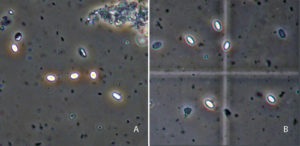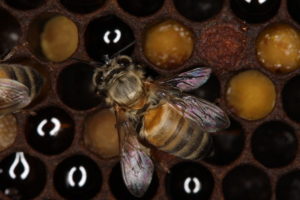Nosema
Nosema apis/ Nosema ceranae

Nosema apis (on left) and Nosema ceranae (on right) (credit: extension.org)
Description
Of the diseases facing Apis mellifera today, Nosema (Nosema apis and Nosema ceranae) remains one of the least understood honey bee maladies. While the mode of transmission and infection are well understood, the implications of an outbreak of disease vary widely between years, apiaries, and even colonies. Historically, N. apis was the only form of Nosema that plagued the United States, particularly in northern areas where honey bee colonies had to overwinter for several months. However, in recent years, N. ceranae has surpassed N. apis as the more common form of Nosema disease and can be found in late winter and early spring as well as during the summer months.
Etiology
Nosema is classified as a microsporidium, which is an obligate, unicellular parasite that belongs to the kingdom Fungi. Microsporidia are intracellular organisms that can only reproduce within the cells of their host. Honey bees become infected with Nosema through the fecal-oral route of transmission. Once a bee ingests a spore, the spore germinates in the midgut. The parasite then enters a cell in the lining of the midgut from which it robs it of nutrients. The parasite increases in size and then divides in two, approximately 24 hours after the initial infection. The parasite continues this pattern of consuming nutrients and dividing within the cell. After 48-60 hours, the parasite has developed new spores. The cell will eventually rupture and die, allowing spores to infect new cells in the midgut as well be expelled with the fecal matter. Within 2 weeks, the parasite has taken up the bee’s midgut at which point there may be between 30-50 million spores found in the midgut. If a bee has not defecated, as would be the case in winter cluster, a bee may have 200 million spores in its intestinal system. Bees will often die of starvation. While workers are more likely to contract Nosema due to the cleaning behavior they perform as a young adult bee, drones and queens can also be affected. Queens with Nosema will slow down laying as their ovaries begin to degenerate. Once she is no longer a valuable member of the colony, she is likely to be superseded.

Honey bee exhibiting K-wing (credit: Nancy Ostiguy, Penn State University)
There are no unique symptoms associated with N. apis or N. ceranae, however, some of the possible symptoms include less productive hives, lower populations, increased winter loss, and increased chance of supersedure. Foraging at an earlier age, disoriented bees, dead and wandering bees in front of the hive, as well as bees exhibiting K-wing are also symptoms. Dysentery is not a symptom of Nosema but is often correlated with the disease. Fecal matter of infected bees contains spores of the parasite, therefore Nosema is spread more rapidly if the bees also have dysentery. The most effective way to diagnose Nosema is by examining crushed bees under a compound microscope using a haemocytometer. Spores are clearly visible under these conditions and the number of spores per bee can be calculated.
Spread and Control
Nosema is spread from colony to colony via drifting and robbing bees that come into contact with infected fecal matter. Water collection sites also act as a repository for the parasite if diseased bees have visited the site and deposited feces in the water. Trophallaxis is another method of spreading Nosema between honey bees within a colony. Spore-contaminated comb remains the greatest source of disease and therefore care should be taken before exchanging frames between colonies. Spores can remain viable in fecal matter in a beehive for more than a year.
The point at which intervention becomes necessary seems to vacillate from year to year and is highly debated. However, currently the most accepted economic threshold level is a count of 1 million spores per honey bee. Fumagilin-B is a soluble powder labeled for use against Nosema and is currently the only chemical treatment on the market for use against this disease. Its use varies depending on your location in North America. Requeening with more resistant stock is also a possible method of control.

